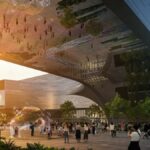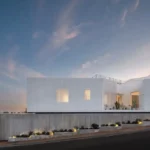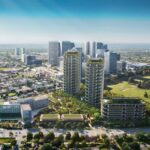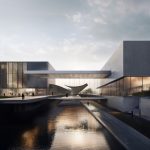Cahill Center, Astronomy and Astrophysics Building, Architect, Caltech
Cahill Center for Astronomy and Astrophysics LA
Caltech Building, Los Angeles, USA – design by Morphosis architects
Jan 26, 2009
Cahill Center for Astronomy and Astrophysics
Design: Morphosis, architects
Cahill Center for Astronomy and Astrophysics Los Angeles
Architect’s Statement
Since the construction of the Palomar Observatory in 1948, the California Institute of Technology (Caltech) has continuously pioneered new ways of observing and explaining the heavens. Caltech scientists and engineers have deployed ever-changing telescopes on satellites, rockets, and balloons, and with these have made fundamental discoveries leading to new theoretical models.
Paramount discoveries that have come out of Caltech include the cosmological nature of distant quasars, gamma-ray bursts, and brown dwarfs. In 2007 alone, Caltech astronomers found the largest object orbiting the sun since the discovery of Pluto in 1930, as well as the most distant galaxy in the universe.
Yet, over the decades, the various specialists dispersed across the Caltech campus. The Cahill Center for Astronomy and Astrophysics brings together a dozen different groups with vastly different cultures, focuses, and scopes into a single structure designed to facilitate collaboration and spontaneous discourse.
In the tradition of ancient and modern architectural observatories found around the world, the building itself conceptually acts as an astronomical instrument. A vertical volume pierces the building, tilting its lens to admit light from the skies. The result is an occupiable telescope, a public stair space that links earth and sky even as it strives to link person to person.
Located on Caltech’s South Campus directly across California Boulevard from the Institution’s historic North Campus core, the Cahill Center physically and symbolically connects the two campuses. The new building’s scale, orientation, horizontal massing, and material language connect with the original complex of Spanish and Mediterranean buildings across California Boulevard (a significant part of the campus’s historic core as envisioned by Bertram Goodhue’s 1917 master plan).
On the south side of the building, the athletic fields appear to extend all the way to the building’s edge. A grove of newly planted sycamore trees, part of the overall landscape strategy, create a natural but permeable boundary.
The new building extends a primary north-south axis across California Boulevard, stitching the two campuses together. A series of north-south interior corridors—literally, “stitches”—reinforce this connection and serve to orient circulation. Floor to ceiling glazing terminates the stitches: the southern façade’s glazing overlooks Caltech’s large, open athletic fields, while the northern façade’s glazing offers views back to the historic core and to the San Gabriel Mountain Range beyond.
All of the building’s laboratories, each configured to accommodate a specific area of research or activity, are located on the basement level of the building. By setting the building back on the site and by carefully sculpting the landscape around the building, the laboratories are granted as much access to natural light as is possible and practical, minimizing the basement feel and strengthening visual connection and accessibility to the ground level and to the campus.
The ground level of the building features a series of public spaces. The entry lobby (which includes the building’s central vertical circulation volume), the 148-seat Hameetman auditorium, and a library maximize the building’s use as a social and gathering space.
The floor to ceiling all glass east wall of the auditorium affords views out to campus an in to the building, further promoting connectivity between the north and south campus. The library, located adjacent to the auditorium at the southeast corner of the building, opens out onto a semi-private deck that overlooks the athletic fields. Shaded by the sycamore grove, a deciduous tree, the deck provides an outdoor gathering space that is pleasant to use throughout the year.
The building is the result of a series of forces that collide to produce unique spaces of discovery. Force lines track the movement of form and light through the building’s faceted façade, the central vertical volume, and the stitches. As one moves through the space, formal fragments coalesce to reconstruct the interactions among light, architectural elements, and bodies as physical traces of the institution’s new ideas.
Cahill Center for Astronomy and Astrophysics – Building Information
Title: Cahill Center for Astronomy and Astrophysics at the California Institute of Technology
Location: Pasadena, California
Site area: 1.0 acres /0.4 hectares
Project Size: 100,010 gross square feet/9,290 gross square meters
Program: Laboratory and administrative academic building with auditorium and library
Project Manager: Kim Groves
Project Architect: David Rindlaub
Job Captain: Salvador Hidalgo
Project Designers: Martin Summers, Shanna Yates
Project Team: Irena Bedenikovic, Pavel Getov, Debbie Lin, Kristina Loock, David Rindlaub
Project Assistants: Patrick Dunn-Baker with Adam Bressler, Laura Foxman, Brock Hinze, Amy Kwok,
Hugo Martinez, Mark McPhie, Barbra Moss, Greg Neudorf, Mike Patterson, Aleksander Tamm-Seitz ,
Rychiee Espinosa, Jennifer Kasick, Kyle Coburn, Christin To, Sunnie Lau
Structural Engineer: John A. Martin & Associates
Mechanical Electrical Plumbing Engineer: IBE Consulting Engineers
Civil Engineer: KPFF Consulting Engineers
Landscape Architect: Katherine Spitz Associates
Laboratory Consultant: Research Facilities Design
Architectural Lighting: Horton Lees Brogden Lighting Design, Inc.
Signage and Graphics: Follis Design
Acoustical Engineer: Martin Newson & Associates, LLC
Audio Visual and Telecommunications: Vantage Technology Consulting Group
Vertical Transportation: Edgett Williams Consulting Group, Inc.
Curtain Wall Consultant: David Van Vokinburg
Code and Security Consultant: Schirmer Engineering Corporation
Specifications: Technical Resources Consultants, Inc.
Cost Estimator: Davis Langdon
General Contractor: Hathaway Dinwiddie Construction Company
The Cahill Center for Astronomy and Astrophysics : main page
Location: Cahill Center for Astronomy and Astrophysics, Los Angeles, Southern California, United States of America
Los Angeles Buildings
Contemporary Los Angeles Architecture
L.A. Architecture Designs – chronological list
Los Angeles Architecture Tours – architectural walks by e-architect
Los Angeles Architecture Designs – Selection
Arcade Boutique, West Hollywood
Montalba Architects
Arcade Boutique
Orange Grove Lofts, 1011 Orange Grove Ave, West Hollywood
Pugh + Scarpa
Orange Grove Lofts
Comments / photos for the Cahill Center for Astronomy and Astrophysics Architecture page welcome




